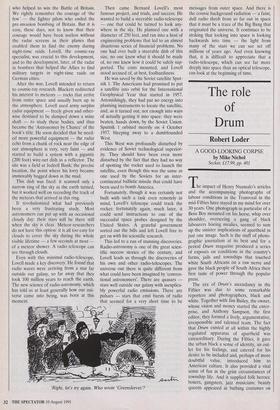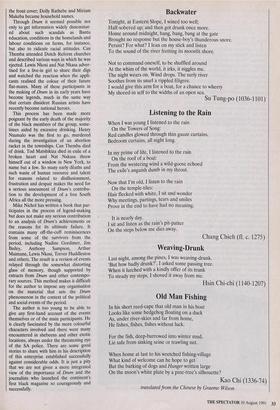The role of Drum
Robert Loder
A GOOD-LOOKING CORPSE by Mike Nichol Secker, £17.99, pp. 401 The impact of Henry Nxumalo's articles and the accompanying photographs of labour conditions in the Transvaal in the mid-Fifties have stayed in my mind for over 30 years. One photograph in particular of a Boss Boy mounted on his horse, whip over shoulder, overseeing a gang of black labourers hoeing mealies, seemed to sum up the sinister implications of apartheid in just one image. Such is the stuff of photo- graphic journalism at its best and for a period Drum magazine produced a series of exposes on conditions in the country's farms, jails and townships that touched white South Africans on a raw nerve and gave the black people of South Africa their first taste of power through the popular press.
The era of Drum's ascendancy in the Fifties was due to some remarkable reporters and photographers, black and white. Together with Jim Bailey, the owner, whose vision and money started the enter- prise, and Anthony Sampson, the first editor, they formed a lively, argumentative, irresponsible and talented team. The fact that Drum existed at all within the highly regulated apparatus of apartheid was extraordinary. During the Fifties, it gave the urban black a sense of identity, an out- let for his feelings, and catered for his desire to be included and, perhaps of more doubtful value, introduced him to American culture. It also provided a vital sense of fun in the grim circumstances of township life. And it supplied folk heroes: boxers, gangsters, jazz musicians; beauty queens appeared in bathing costumes on
the front cover; Dolly Rathebe and Miriam Makeba became household names.
Through Drum it seemed possible not only to get information widely disseminat- ed about such scandals as Bantu education, conditions in the homelands and labour conditions on farms, for instance, but also to ridicule racial attitudes. Can Themba attended Dutch Reform churches and described various ways in which he was ejected. Lewis Nkosi and Nat Nkasa adver- tised for a live-in girl to share their digs and watched the reaction when the appli- cants realised the colour of their future flat-mates. Many of these participants in the making of Drum in its early years have become legends, much in the same way that certain dissident Russian artists have recently become national heroes.
This process has been made more poignant by the early death of the majority of the black members of the group, some- times aided by excessive drinking. Henry Nxumalo was the first to go, murdered during the investigation of an abortion racket in the townships. Can Themba died of drink. Tod Matshikiza died in exile of a broken heart and Nat Nakasa threw himself out of a window in New York, to name but a few. So many early d'e'aths and such waste of human resource and talent for reasons related to disillusionment, frustration and despair makes the need for a serious assessment of Drum's contribu- tion to the development of a free South Africa all the more pressing.
Mike Nichol has written a book that par- ticipates in the process of legend-making but does not make any serious contribution to an analysis of Drum's achievements or the reasons for its ultimate failure. It contains many off-the-cuff reminiscences from some of the survivors from the period, including Nadine Gordimer, Jim Bailey, Anthony Sampson, Arthur Maimane, Lewis Nkosi, Trevor Huddleston and others. The result is a version of events relayed through the somewhat distorting glass of memory, though supported by extracts from Drum and other contempo- rary sources. This method makes it difficult for the author to impose any organisation on the material that sets the Drum phenomenon in the context of the political and social events of the period.
The author is too young to be able to give any first-hand account of the events themselves or of the main participants. He is clearly fascinated by the more colourful characters involved and there were many encountered in shebeens and other exotic locations, always under the threatening eye of the SA police. There are some good stories to share with him in his description of this enterprise established successfully against considerable odds. It is just a pity that we are not given a more integrated view of the importance of Drum and the journalists who launched the continent's first black magazine so courageously and successfully.



















































 Previous page
Previous page